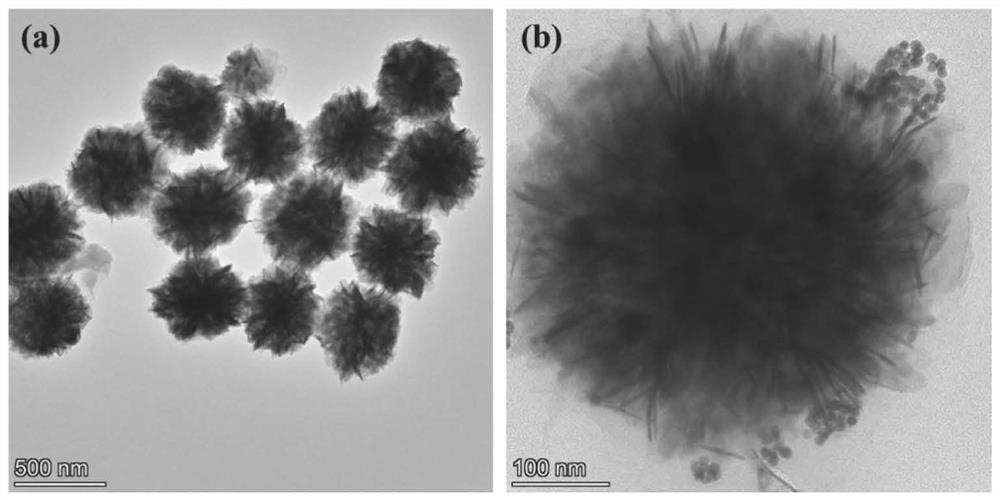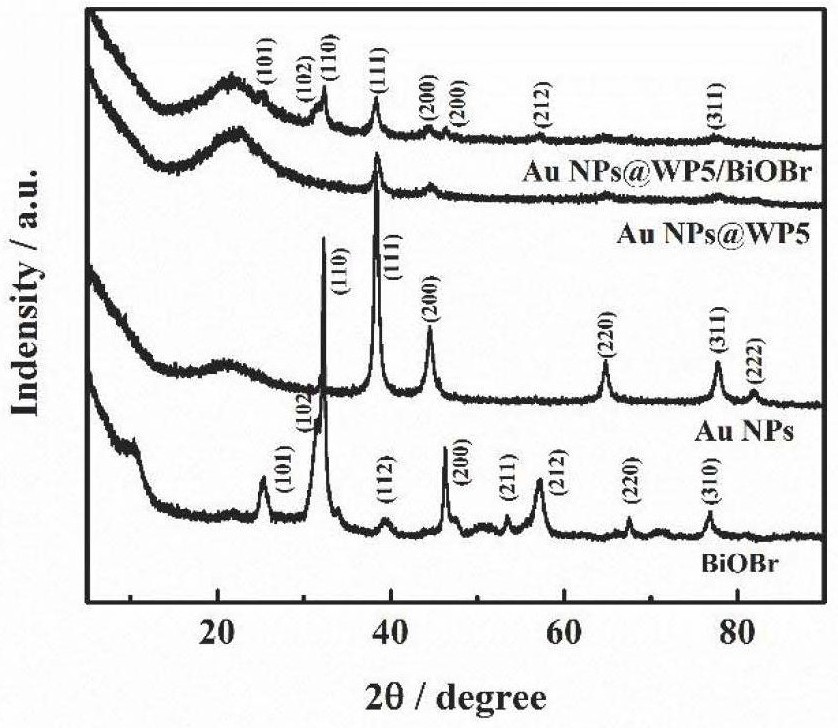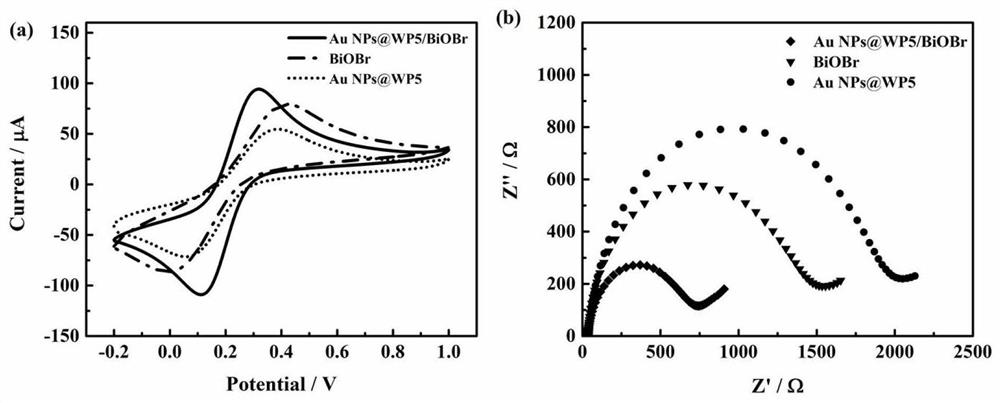Preparation method and application of Au NPs coated WP5/BiOBr composite material
A composite material and mixed solvent technology, applied in the field of photoelectrochemistry, can solve the problems of requiring special operators, environmental pollution, low sensitivity of detection technology, etc.
- Summary
- Abstract
- Description
- Claims
- Application Information
AI Technical Summary
Problems solved by technology
Method used
Image
Examples
Embodiment 1
[0033] A preparation method of Au NPs@WP5 / BiOBr composite material, the steps are:
[0034] Step 1, preparing bismuth oxybromide nanoflowers: 0.485g Bi(NO) 3˙ 5H 2 O was added to 30 mL of mixed solvent, the mixed solvent (V 水 :V 乙二醇 = 1:5), a transparent solution was obtained after ultrasonic dispersion, 0.4 g of PVP was added, stirred for 30 min, and then 0.119 g of KCl was added and stirred for 30 min to obtain a white suspension solution. The white suspension was poured into an autoclave, reacted in an oven at 160 °C for 3 h, and dried by centrifugation to obtain a pale yellow powder of BiOBr, that is, bismuth oxybromide nanoflowers.
[0035] Step 2, prepare gold nanoparticles by reducing chloroauric acid: take 150 mL of deionized water, heat it to boiling, add 0.9 mL of H 3 cit (0.1 M), 2.1 mL Na 3 cit (0.1 M), stirred for 15 min, injected 1 mLHAuCl 4 (25.4 mM), continue to stir for 3 min, put into ice water to quench to obtain wine red Au NPs aqueous solution; centr...
Embodiment 2
[0040] Physical characterization:
[0041] Morphology determination of BiOBr, Au NPs@WP5 / BiOBr.
[0042] figure 1 (a) and (b) are the transmission electron microscope images of the BiOBr nanoflowers prepared in step 1 and the Au NPs@WP5 / BiOBr prepared in step 5 in Example 1, respectively. The results show that the diameter of the synthesized BiOBr nanoflowers can be observed in diagram (a) is 400-450 nm, and the dispersion is uniform. It can be seen from the diagram (b) that the prepared Au NPs@WP5 are relatively uniformly dispersed in the sheets of BiOBr nanoflowers, which indicates the successful preparation of Au NPs@WP5 / BiOBr composites.
[0043] XRD powder diffraction and infrared characterization of Au NPs@WP5 / BiOBr composites.
[0044] figure 2 is the XRD powder diffraction pattern of BiOBr, Au NPs, Au NPs@WP5, and Au NPs@WP5 / BiOBr composite materials prepared in step 5. It can be seen from the figure that for Au NPs@WP5 / BiOBr, at 21.51°, 25.07°, 25.29°, 43.90°, a...
Embodiment 3
[0046] Electrochemical property test of dopamine:
[0047] 10 μL of Au NPs@WP5 / BiOBr obtained in the above Example 1 was drop-coated on the surface of GCE, and dried beside an infrared lamp at 50 °C to obtain Au NPs@WP5 / BiOBr modified GCE. Dissolve dopamine in PBS with PH=7.0 as the test object. Through the traditional three-electrode method, use a xenon lamp to simulate a visible light source to irradiate the surface of the GCE electrode, control the shading interval as an adjustable "on-off", and then use the electrochemical workstation Perform photoelectrochemical detection.
[0048] Electrochemical Characterization:
[0049] As shown in Figure 3, by adding 5.0 mM K 3 [Fe(CN) 6 ] / K 4 [Fe(CN) 6 ] and 0.1 M KCl solution to explore the electrochemical activity of BiOBr / GCE, Au NPs@WP5 / GCE and Au NPs@WP5 / BiOBr / GCE electrodes. It can be clearly seen that compared with BiOBr / GCE and Au NPs@WP5 / GCE, Au NPs@WP5 / BiOBr / GCE has the largest oxidation peak current value, which may...
PUM
| Property | Measurement | Unit |
|---|---|---|
| Diameter | aaaaa | aaaaa |
Abstract
Description
Claims
Application Information
 Login to View More
Login to View More - R&D
- Intellectual Property
- Life Sciences
- Materials
- Tech Scout
- Unparalleled Data Quality
- Higher Quality Content
- 60% Fewer Hallucinations
Browse by: Latest US Patents, China's latest patents, Technical Efficacy Thesaurus, Application Domain, Technology Topic, Popular Technical Reports.
© 2025 PatSnap. All rights reserved.Legal|Privacy policy|Modern Slavery Act Transparency Statement|Sitemap|About US| Contact US: help@patsnap.com



